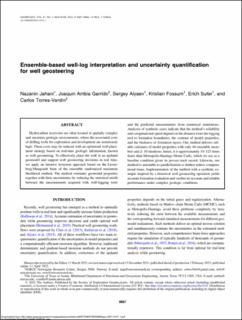| dc.contributor.author | Jahani, Nazanin | |
| dc.contributor.author | Ambia Garrido, Joaquin | |
| dc.contributor.author | Alyaev, Sergey | |
| dc.contributor.author | Fossum, Kristian | |
| dc.contributor.author | Suter, Erich Christian | |
| dc.contributor.author | Torres-Verdin, Carlos | |
| dc.date.accessioned | 2022-06-13T13:26:26Z | |
| dc.date.available | 2022-06-13T13:26:26Z | |
| dc.date.created | 2022-01-31T15:00:44Z | |
| dc.date.issued | 2022 | |
| dc.identifier.citation | Geophysics. 2022, 87 (3), . | en_US |
| dc.identifier.issn | 0016-8033 | |
| dc.identifier.uri | https://hdl.handle.net/11250/2998569 | |
| dc.description.abstract | Hydrocarbon reservoirs are often located in spatially complex and uncertain geologic environments, where the associated costs of drilling wells for exploration and development are notoriously high. These costs may be reduced with an optimized well-placement strategy based on real-time geologic information, known as well geosteering. To effectively place the well in an updated geomodel and support well geosteering decisions in real time, we apply an iterative inversion approach based on the Levenberg-Marquardt form of the ensemble randomized maximum likelihood method. The method estimates geomodel properties together with their uncertainties by reducing the statistical misfit between the measurements acquired with well-logging tools and the predicted measurements from numerical simulations. Analyses of synthetic cases indicate that the method’s reliability and computational speed depend on the distance from the logging tool to formation boundaries, the contrast of model properties, and the thickness of formation layers. Our method delivers reliable estimates of model properties with only 40 ensemble members and 2–10 iterations; hence, it is approximately 10–125 times faster than Metropolis-Hastings Monte Carlo, which we use as a baseline condition given its proven track record. Likewise, our method is amenable to parallelization to further reduce computational times. Implementation of the method with a synthetic example inspired by a historical well geosteering operation yields accurate formation evaluation and verifies its accurate and reliable performance under complex geologic conditions. | en_US |
| dc.language.iso | eng | en_US |
| dc.rights | Navngivelse 4.0 Internasjonal | * |
| dc.rights.uri | http://creativecommons.org/licenses/by/4.0/deed.no | * |
| dc.title | Ensemble-Based Well-Log Interpretation and Uncertainty Quantification for Well Geosteering | en_US |
| dc.title.alternative | Ensemble-Based Well-Log Interpretation and Uncertainty Quantification for Well Geosteering | en_US |
| dc.type | Peer reviewed | en_US |
| dc.type | Journal article | en_US |
| dc.rights.holder | © 2022 The Authors | en_US |
| dc.description.version | publishedVersion | en_US |
| cristin.ispublished | true | |
| cristin.fulltext | original | |
| cristin.qualitycode | 2 | |
| dc.identifier.doi | 10.1190/geo2021-0151.1 | |
| dc.identifier.cristin | 1995032 | |
| dc.source.journal | Geophysics | en_US |
| dc.source.volume | 87 | en_US |
| dc.source.issue | 3 | en_US |
| dc.source.pagenumber | 10 | en_US |
| dc.relation.project | Norges forskningsråd: 309589 | en_US |

